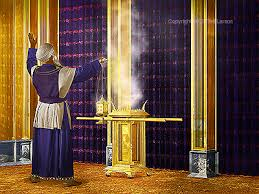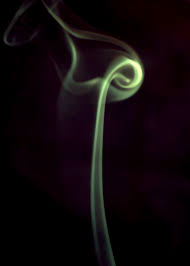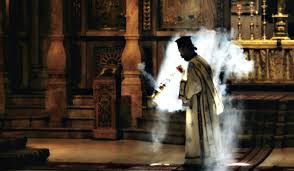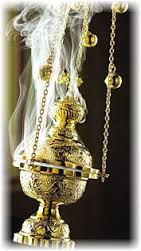In the high church liturgy of the Eastern Orthodox and Roman Catholic traditions incense is used in worship. The religious practice of burning incense has a long history having been part of the ritual of ancient Israel.
The first to represent Israel as high priest was Aaron who was Moses’ brother. In his religious duties was the clear delineation of burning incense before the Lord: “Aaron shall burn fragrant incense on it; he shall burn it every morning when he trims the lamps. “When Aaron trims the lamps at twilight, he shall burn incense. There shall be perpetual incense before the LORD throughout your generations. “You shall not offer any strange incense on this altar, or burnt offering or meal offering; and you shall not pour out a drink offering on it” (Exodus 30:7-9).
As the priesthood was passed on to each new generation, priests continued to burn incense in the Tabernacle and then later in the Temple: “Every morning and evening they burn to the LORD burnt offerings and fragrant incense, and the showbread is set on the clean table, and the golden lampstand with its lamps is ready to light every evening…” (2 Chronicles 13:11).
In his own devotional life, David used the idea of burning incense to illustrate his prayers ascending to heaven: “Let my prayer be set before You as incense, The lifting up of my hands as the evening sacrifice” (Psalm 141:2). Interestingly Zechariah the father of John the Baptist was in the Temple burning incense when an angel told him of his wife’s unexpected mid-life pregnancy (See: Luke 1:5-20).
In the first century those who provided leadership for the newly established Christian faith were Jews. Most likely they saw connections between the rituals of the Judaism and the finished work of redemption in Christ. Early Church Fathers saw in the Scriptures the smoke of incense as a visual aid to the believers’ prayers rising up to heaven.
Likewise, the Apostle John in the Book of Revelation made the connection between incense and the prayers of the saints:
“When He opened the seventh seal, there was silence in heaven for about half an hour. 2 And I saw the seven angels who stand before God, and to them were given seven trumpets. 3 Then another angel, having a golden censer, came and stood at the altar. He was given much incense, that he should offer it with the prayers of all the saints upon the golden altar which was before the throne. 4 And the smoke of the incense, with the prayers of the saints, ascended before God from the angel’s hand” (Revelation 8:1-4).
The practice of burning incense has continued both in Roman Catholic and Eastern Orthodox traditions into our present day. The actual component parts used to prepare incense is fascinating. A “thurible” is a type of censer in which the incense burns. The “boat bearer” holds the incense which is spooned into the thurible already charged with burning red-hot charcoal. The censer is then suspended by a chain and swung from side to side following a format of ritual.
Thurible, cup from inside thurible, incense boat, charcoal holder, and tongs
The fragrant smoke is then used as a sanctifying symbol in different kinds of religious ceremonies. In the Orthodox Church and traditional Roman Catholic Churches incense is used in virtually every service.
C. S. Lewis carried in his library writings by Jeremy Taylor a 17th century clergy in the Church of England. He has been called the” Shakespeare of Divines” for his poetic style of expression. Although a Protestant Jeremy Taylor recognized the visual power of viewing ascending incense as the prayers of believers.
“The power of grace has subdued all his enemies: is three power. They serve him night and day, giving him praise night and day, This is the religion and worship of God in the temple,. The temple itself is the heart of man; Christ is the High Priest, who from there sends the incense of prayers, and joins them in intercession, and present all together to his Father, and the Holy Ghost, by his dwelling here, has also consecrated it into a temple.” – Jeremy Taylor (p. 229, From The Library of C. S. Lewis)
So what is the take away value for the idea of burning incense in Christian liturgy? The high church advocate would most likely tell us that the worship service should not just appeal to our minds and hearts but also to our senses. The power of fragrance to bring back memories is well known. In the case of incense we can be reminded of our need for prayer. It also can bring to mind that we are to exude the spiritual fragrance of Christ to those we encounter through out the day (2 Corinthians 2:14-16).
What are your thoughts about the value of incense in Christian worship?









The scent of incense was the most memorable welcome I received upon entering an Orthodox Church over 25 years ago. Today as we enter through the door, even down the hall before we get to the Nave this aroma reminds me I am entering a sacred space and it prepares me for worship.
“Lay Aside All Earthly Cares” is a song sung every Sunday during Liturgy. The smell of incense invites me to put aside all care and focus on the Lord Jesus Christ. It calls me to prayer. Another one of my favorite songs sung during the Lenten services is “Let my prayer be set before You as incense, The lifting up of my hands as the evening sacrifice” (Psalm 141:2).
If you have never heard this chant from Psalm 141:2 sung I invite you to this link
to listen.
LikeLike
Thank you for sharing this video with the Eastern Orthodox chant. Recently, I visited a Greek Orthodox Church and felt through sight, sound and smell as though I were on the outposts of heaven
LikeLike
Despina – Thanks for your comment and video. My worship tradition does not use incense, but I do know that when I walk into a Catholic or Orthodox church, the smell of incense (even if from services long past) reminds me that I am in sacred space. I find that the more reminders of the sacred in my life, the better! I often need outward signs of the call to be a worship-filled follower of Christ.
LikeLike
Amen!
LikeLike
The burning of incense in liturgical churches has not found a counter part in protestant churches for the most part. Icons have, however, on the other hand, though greatly reduced in number and significance, for example crosses inside and outside of churches, stained glass windows, Bible carvings and picture books depicting biblical scenes, a special communion table with the phrase “This do in Remembrance of me,” cross necklaces, lapel pins, bracelets with WWJD among others.
The incense imagery is replete in the O.T. symbolizing ascending prayers and a bit in the N.T. though greatly diminished. If my memory is not failing me, I am unaware of incense burning practiced outside of the temple. On the contrary there were restrictions in its use or abuse. I also believe that my limited research shows that incense is not used in synagogue services. I have not been inclined to consider a protestant counter part with all due respect to those who make use of it in liturgical services.
The testimonials are that it creates an ambience for worship and prayer. It could just as well pose a problem. The smoke could remind some of the death of a loved one in a fire or provoke a fit of coughing (this is not meant to trivialize those who practice the use of incense). I asked myself on one occasion how many are paying as the incense is carried through the congregants? Why do we need to think of prayers ascending? Does not the mind, in an act of prayer, perceive the prayer raising the God whose throne is high above the starry heavens?
There seems to me to be some correlation between incense burning, reserved for the cleric and candle burning which can be practiced by the laity as they offer up petitions. It seems that it has a fetish value in the minds of the people with whom I worked in Brasil. There is a church of the martyrs where candle burning is so excessive that they have powerful blowers to dissipate the heat. In another instance where tens of thousands visit a cathedral there was a sign by the burning platform “It is not necessary to burn the candle for it to be effective.” I’m inclined to believe that there is a disconnect between the clerics who have a better understanding of icons and incense than the laity who participate in these services. Veneration is on the horizon for many of those in Brasil.
LikeLike
Thank your for your careful analysis and variety of cross cultural examples. I believe that the task of every pastor or priest is to help remove error in the minds of lay people replacing this with the truth of God’s Word. Certainly to introduce major liturgical elements increases the importance of orthodoxy as well as orthopraxy.
LikeLike